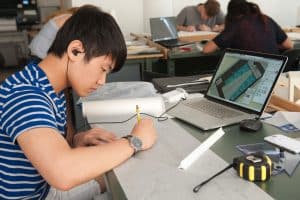Exploring the UCLA Neuroscience Program
Are you interested in exploring the dynamic world of neuroscience? Look no further than the Neuroscience Program at the University of California, Los Angeles (UCLA). In this article, we will delve into the history, curriculum, faculty, research opportunities, student life, the application process, upcoming projects, alumni success stories, and interdisciplinary collaborations of UCLA’s Neuroscience Program. Whether you are a prospective student or simply curious about the field, join us on this exploratory journey.

The History and Founding of UCLA’s Neuroscience Program
The Neuroscience Program at UCLA was established in 1990 to serve as an interdisciplinary hub for neuroscientists across departments. Today, it is one of the leading neuroscience programs in the world, boasting over 100 faculty members and 200 graduate students from diverse backgrounds and fields.
The program’s founding was spearheaded by Dr. Michael S. Gazzaniga, a renowned cognitive neuroscientist who recognized the need for a collaborative and integrated approach to studying the brain. Under his leadership, the program has grown to encompass research in areas such as neural development, neurodegenerative diseases, and computational neuroscience.
An Overview of the Neuroscience Curriculum at UCLA
The Neuroscience curriculum at UCLA covers a wide range of topics, including cellular and molecular neuroscience, cognitive neuroscience, computational neuroscience, developmental neuroscience, systems neuroscience, and neurobiology of disease. Students can pursue a wide range of degrees, including a Bachelor of Science in Neuroscience or a Ph.D. in Neuroscience. Additionally, students have access to various elective courses to supplement and customize their education.
One unique aspect of the Neuroscience curriculum at UCLA is the opportunity for students to participate in research projects. Undergraduate students can work in research labs alongside faculty members and graduate students, gaining hands-on experience in the field. Graduate students have the opportunity to conduct their own research projects with access to state-of-the-art facilities and resources. This emphasis on research allows students to apply their knowledge and skills to real-world problems and prepares them for careers in academia, industry, or healthcare.
The Faculty and Researchers behind UCLA’s Neuroscience Program
The faculty and researchers of UCLA’s Neuroscience Program are internationally recognized leaders in the field. Their research spans topics such as neural development, learning and memory, neurodegenerative diseases, and more. Notable faculty members include Dr. Kelsey Martin, Dr. Carlos Portera-Cailliau, and Dr. Larry Zipursky, to name just a few.
Dr. Kelsey Martin, the Dean of the David Geffen School of Medicine at UCLA, is a renowned neuroscientist whose research focuses on the molecular mechanisms of learning and memory. Dr. Carlos Portera-Cailliau, a professor of neurology and neurobiology, studies the development and function of neural circuits in the brain. Dr. Larry Zipursky, a professor of biological chemistry, investigates the genetic and molecular basis of neural development and function.
In addition to these faculty members, UCLA’s Neuroscience Program also boasts a talented group of researchers and postdoctoral fellows. These individuals work alongside faculty members to conduct cutting-edge research and contribute to the program’s reputation as a leader in the field of neuroscience. Together, the faculty and researchers of UCLA’s Neuroscience Program are dedicated to advancing our understanding of the brain and improving treatments for neurological disorders.
Research Opportunities Available to UCLA’s Neuroscience Students
UCLA’s Neuroscience Program offers numerous opportunities for students to engage in cutting-edge research. These opportunities range from assistantships, research labs, and internships to summer research programs and research conferences. Students can work on projects ranging from bench-to-bedside translations in various areas of neuroscience, including developmental neurobiology, cellular and molecular neuroscience, computational and systems neuroscience, and neurodegenerative diseases.

Additionally, UCLA’s Neuroscience Program has partnerships with various research institutions and hospitals in the Los Angeles area, providing students with access to state-of-the-art facilities and equipment. These partnerships also offer students the chance to work alongside leading researchers in the field and gain valuable hands-on experience. Furthermore, the program encourages students to present their research at national and international conferences, providing them with opportunities to network with other professionals and showcase their work to a wider audience.
Student Life within the Neuroscience Program Community at UCLA
Another crucial aspect of UCLA’s Neuroscience Program is its thriving student community. Students have access to a range of resources and support, from student groups to peer mentoring programs to academic advising. Additionally, numerous social events and extracurricular activities are available for students to get involved with, such as the Society for Neuroscience Student Chapter or the annual Brain Awareness Week event.
One of the most popular student groups within the Neuroscience Program is the Brain Research Institute Student Association (BRISA). This group provides students with opportunities to attend seminars, workshops, and networking events with leading researchers in the field. BRISA also hosts an annual research symposium, where students can present their own research and receive feedback from faculty and peers.
Furthermore, the Neuroscience Program at UCLA offers unique opportunities for students to gain hands-on research experience. Many students participate in research projects with faculty members, and some even have the opportunity to conduct their own independent research. This experience not only enhances their academic and professional skills but also helps them to develop a deeper understanding and appreciation for the field of neuroscience.
Applying to UCLA’s Neuroscience Program: Requirements and Tips
Do you have what it takes to become a part of UCLA’s Neuroscience Program? The application process requires a strong academic record, previous research experience, and a passion for neuroscience. Academic requirements include a bachelor’s degree from an accredited institution and a minimum GPA of 3.0. The application process itself is relatively straightforward, requiring personal and academic statements, transcripts, and letters of recommendation. Additionally, it is recommended that prospective students connect with current students, faculty, and alumni of the program for advice and guidance on the application process.
One important aspect to consider when applying to UCLA’s Neuroscience Program is the availability of research opportunities. The program offers a variety of research labs and centers, providing students with the chance to gain hands-on experience in the field. It is highly recommended that applicants highlight any previous research experience in their application, as this can greatly increase their chances of being accepted into the program.
Another factor to keep in mind is the competitive nature of the program. UCLA’s Neuroscience Program is highly selective, with a low acceptance rate. It is important for applicants to showcase their unique skills and experiences in their application and to demonstrate a strong commitment to the field of neuroscience. Prospective students should also be prepared to put in a significant amount of time and effort into their application, as well as their studies, if accepted into the program.
The Future of Neuroscience at UCLA: Upcoming Research Projects and Initiatives
The future looks bright for UCLA’s Neuroscience Program, with a wide range of upcoming research projects and initiatives. Some notable initiatives include the UCLA Neurobiology Initiative, which aims to unravel the fundamentals of neural circuits and systems, and the Transformative Institute for Neuroscience Innovation and Discovery (TIND), which focuses on accelerating the discovery of new treatments and cures for neurological disorders.
In addition to these initiatives, UCLA’s Neuroscience Program is also collaborating with other departments and institutions to further advance the field. One such collaboration is with the UCLA Department of Psychology, where researchers are exploring the intersection of neuroscience and psychology to better understand human behavior and cognition. Another collaboration is with the Semel Institute for Neuroscience and Human Behavior, where researchers are investigating the underlying mechanisms of mental illnesses such as depression and schizophrenia.
Alumni Success Stories: Graduates of UCLA’s Neuroscience Program Making an Impact in the Field
UCLA’s Neuroscience Program has produced numerous successful alumni who have gone on to make significant contributions to the field. These alumni include Dr. Nicole Calakos, a neurologist exploring the role of glutamate receptors in Huntington’s disease, and Dr. Dawn Loh, a postdoctoral researcher studying the neural mechanisms underlying fear and anxiety. Their success stories demonstrate the power of UCLA’s Neuroscience Program in shaping the future of neuroscience.
Collaborations with Other Departments and Institutions: How UCLA’s Neuroscience Program is Advancing Interdisciplinary Research
Finally, the interdisciplinary nature of UCLA’s Neuroscience Program allows for collaborations with other departments and institutions to advance research in neuroscience. Partnerships with departments such as psychology, engineering, mathematics, and computer science have yielded significant progress in neuropsychology, neural imaging, and neural network modeling. The program also collaborates with outside institutions, such as the nearby Cedars-Sinai Medical Center and the California NanoSystems Institute, to expand its research reach.

In conclusion, UCLA’s Neuroscience Program provides an exceptional educational experience for aspiring neuroscientists. With a rigorous and diverse curriculum, world-renowned faculty, cutting-edge research opportunities, and a supportive community, it is no wonder that the program continues to produce outstanding alumni and lead the way in groundbreaking neuroscience research.
One notable collaboration that UCLA’s Neuroscience Program has established is with the Semel Institute for Neuroscience and Human Behavior. This partnership has allowed for the integration of clinical research and treatment into the program’s curriculum, providing students with a unique opportunity to learn about the practical applications of neuroscience. Additionally, the program has partnered with the UCLA Brain Research Institute to further advance research in areas such as neurodegenerative diseases and brain injury. These collaborations demonstrate the program’s commitment to interdisciplinary research and its dedication to making meaningful contributions to the field of neuroscience.



































